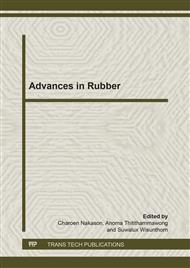p.3
p.7
p.11
p.15
p.20
p.24
p.30
p.34
p.41
A Simple Water Balance Model of Rubber Tree Plantations under Different Evaporative Demand Regimes
Abstract:
Drought constraints and transpiration of rubber (Hevea brasiliensis) plantations under different evaporative demand regimes were assessed by the simple water balance model. A lump water model, BILJOU (BILan hydrique JOUrnalier), is the daily water balance model. This model requires daily potential evapotranspiration (ETo) and rainfall as input climatic data, also requires site and stand parameters are maximum extractable soil water and leaf area index (LAI). The study was carried out two sites; namely Songkhla and Chachoengsao province, Thailand, traditional and new plantation area, respectively. The calibration of this model was done with sap flow measurements. Soil water derived by tensiometer for Songkhla and soil sampling for Chachoengsao were used to validate the model. Under non limiting soil water and full canopy, transpiration of rubber was influenced by evaporative demand. Consistently, under limited soil water represented as threshold of relative extractable water (REWc < 0.4), transpiration was influenced by REW. In the new plantation area; Chachoengsao, drought constraints were evident annually from the beginning of senescence until the new accomplished flushing; December to June. However, at Songkhla site, transpiration and soil water was mainly driven by evaporative demand. And the limitation of soil water represented shortly during the plateau stage of LAI.
Info:
Periodical:
Pages:
20-23
Citation:
Online since:
November 2013
Keywords:
Price:
Сopyright:
© 2014 Trans Tech Publications Ltd. All Rights Reserved
Share:
Citation:


